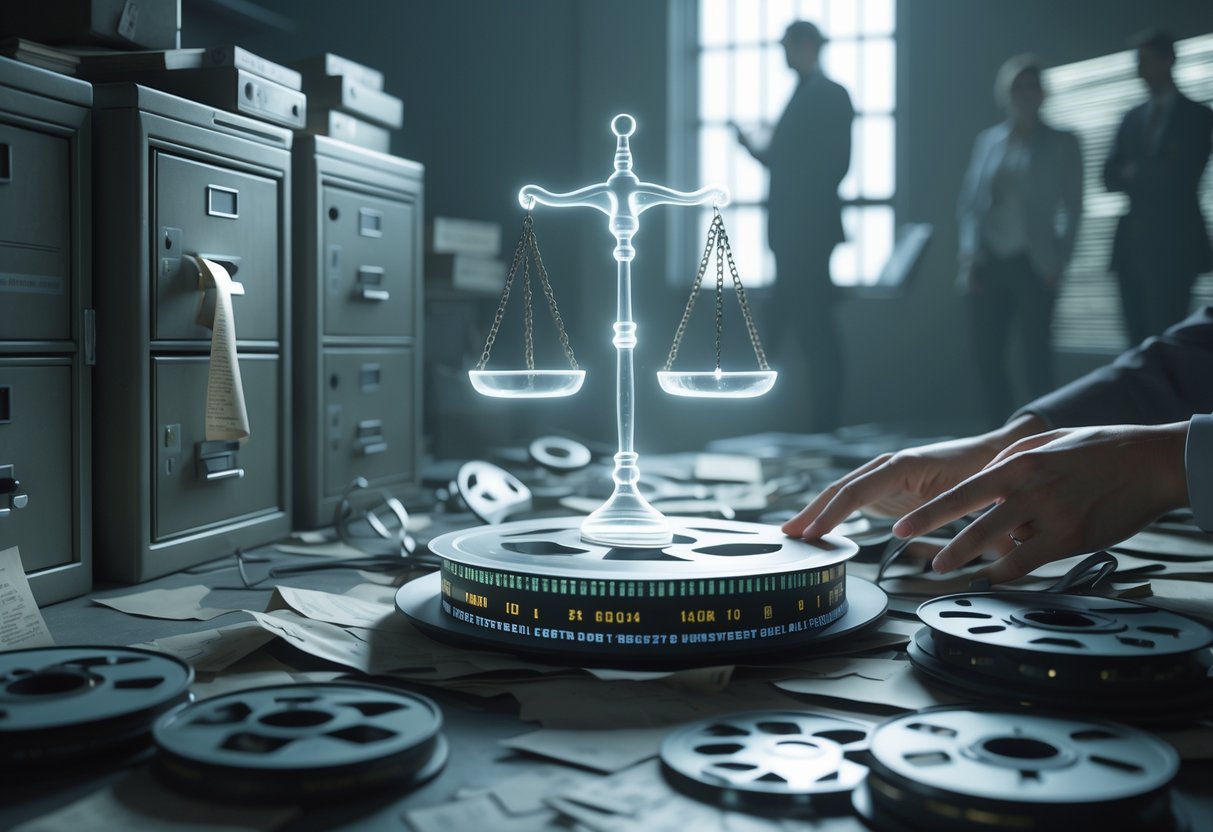Lost Footage Importance: Why Preserving Media Matters
Updated On: November 13, 2025 by Aaron Connolly
Understanding Lost Footage
When footage gets lost, years of work can just vanish. Creators suddenly find themselves without the content they need for their projects.
This happens in film productions, security systems, and even personal recordings. Usually, it’s because backup systems fail or accidents happen.
Definition and Types of Lost Footage
Lost footage means any video content you can’t access anymore—maybe it’s deleted, corrupted, or just missing from its original storage. This can hit any kind of recorded material, honestly.
Film and Television Footage
Production companies sometimes lose raw footage from memory cards, hard drives, or even the cloud. Behind-the-scenes clips, interviews, and main shooting footage can all disappear.
Security Camera Footage
CCTV and DVR systems lose recordings through hardware failures or accidental deletion. Sometimes, that footage is crucial for investigations.
Personal Recordings
Home videos, family memories, and personal projects can vanish from phones, cameras, or computers. Losing these hurts on a whole different level.
Gaming and Streaming Content
Gamers and content creators lose gameplay, live streams, or edited videos. That makes it tough to keep audiences engaged or keep up a steady flow of content.
The type of lost footage really shapes how we try to recover it.
Common Causes of Footage Loss
A bunch of things can make footage disappear from storage. Knowing the causes helps us avoid future headaches.
Hardware Failures
Hard drives crash, memory cards corrupt, and storage devices just die sometimes. DVRs and cameras overheat or break down out of nowhere.
Human Error
We delete files by accident, format drives we shouldn’t, or overwrite important stuff. Bad file management just adds to the confusion.
Automatic Overwriting
Security systems often delete old footage when storage fills up. A lot of CCTV setups overwrite recordings after a set number of days.
Cyber Attacks
Ransomware can lock up video files, and hackers sometimes delete or steal footage from the cloud. Weak security just makes things worse.
Environmental Damage
Fire, water, or extreme temperatures can wreck storage devices. Power surges and electrical issues corrupt data, too.
Software Issues
Operating system crashes, corrupted file systems, and software bugs can make footage vanish. Sometimes, updates mess up compatibility with older files.
Historical Examples
Some high-profile cases really show how damaging lost footage can be.
Film Industry Losses
Pixar almost lost two years of work on Toy Story 2 when someone deleted the master files by accident. Only a backup on an animator’s home computer saved the day.
Most silent films from the early 1900s disappeared because of film degradation and bad storage. Around 75% of all silent films are just gone.
Security Footage Cases
During the 2013 Boston Marathon bombing investigation, authorities needed CCTV footage. Some cameras had already overwritten crucial evidence before anyone could grab it.
Personal and Cultural Losses
Hurricane Katrina wiped out countless family videos and historical recordings in New Orleans homes. That kind of loss really drives home the need for off-site backups.
The BBC accidentally erased hundreds of early Doctor Who episodes in the ’60s and ’70s. Only fan recordings and foreign broadcasts kept a few of those classics alive.
These stories make it clear—lost footage hits investigations, entertainment, and personal history everywhere.
Significance of Lost Footage in Media Preservation

Lost footage isn’t just about missing entertainment. It’s about losing pieces of our cultural heritage, sometimes forever.
The impact goes way beyond movies. We’re talking about educational resources, historical documentation, and how society understands itself.
Cultural and Historical Value
Lost footage gives us a glimpse into past societies. It documents everything from daily life to major historic moments.
When we lose this stuff, we lose genuine perspectives you can’t really recreate.
Take silent films from the early 1900s. The Library of Congress says about 75% are gone for good. They weren’t just movies—they showed off the fashion, architecture, and attitudes of the time.
What we lose includes:
- Original creative visions before edits or censorship
- Behind-the-scenes looks at creative processes
- Rare interviews with historical figures
- Unedited news footage from important events
Early TV shows faced the same risks. The BBC trashed a lot of old shows up until 1974, including Doctor Who episodes. Those shows captured the humor, culture, and issues of their day.
Personal recordings might have the most honest cultural value of all. Home movies, local news, and community events show real life, unfiltered.
Impact on Society
Lost footage changes how future generations learn about their past. Schools and universities use preserved media to teach history, media, and culture.
When footage disappears, we can’t fact-check historical claims or provide visual proof. That leaves gaps in our collective memory.
Societal consequences include:
- Fewer resources for students and researchers
- Lost perspectives, especially from marginalized groups
- Gaps in studying technical or artistic changes
- Missing records of social movements and culture shifts
A lot of important documentaries and news programs now exist only in pieces, if at all. It limits how we understand big events like wars or political changes.
Keeping this stuff safe gets harder as technology moves on. Old formats become obsolete, and without active efforts to transfer them, whole collections can just disappear—even if the physical tapes or reels survive.
High-Profile Lost Footage Cases

History is packed with incidents that show how devastating lost footage can be. Beloved films, historic events, even space missions—no one’s immune.
Toy Story 2 Incident
Pixar almost lost all of Toy Story 2 in 1998. Someone ran a command that wiped out 90% of the movie’s files.
It happened during a routine cleanup. In minutes, characters, scenes, and months of animation work vanished.
What made it worse:
- The backup system had been broken for weeks
- Nobody noticed until the files were gone
- The film was deep in production, with millions already spent
Luckily, technical director Galyn Susman had a copy at home. Her backup saved the whole project.
Pixar changed their storage approach after that. Now, they use multiple backup systems and check them often.
NASA’s Moon Landing Tapes
NASA erased the original high-quality tapes of the 1969 moon landing. Those master tapes had the clearest footage of Neil Armstrong stepping onto the moon.
They reused the tapes in the ’70s and ’80s to save money, recording over the historic footage with satellite data.
Key details:
- The lost tapes were the best versions
- Lower quality copies still exist and aired on TV
- The originals would’ve shown much more detail
NASA tried to restore the footage from other sources, but they never matched the quality of the originals.
Even big organizations can lose priceless footage with bad storage policies.
Classic Hollywood Films
Thousands of early Hollywood films are gone forever. Most silent films from the 1920s simply didn’t survive.
Why did this happen?
- Nitrate film stock was flammable and unstable
- Studio fires wiped out entire archives
- Studios destroyed films to save space
- Chemical decay turned films to dust
Lost films included work by big-name directors and stars. Studios usually kept only one master copy, so recovery was impossible if that one got damaged.
The 1937 Fox Film Corporation fire destroyed most of their silent films. Other studios had similar disasters.
Sometimes, people find partial copies in private collections or foreign archives. But most of these films are just gone.
Rediscovered Archival Footage
Not every lost footage story ends badly. Sometimes, important films and recordings turn up decades later in unexpected places.
The 1927 film Metropolis was incomplete for 80 years. Then, in 2008, someone found a nearly complete copy in an Argentine museum—25 minutes of lost scenes.
Other rediscoveries:
- Beatles concert footage in private hands
- Early Disney cartoons in studio vaults
- Historic newsreels in foreign archives
These finds usually happen by accident. Collectors, archivists, or even family members stumble on valuable footage in attics or storage.
Digital restoration now lets experts repair footage that used to be considered lost for good. There’s always hope for more discoveries.
Digital Asset Management for Footage Protection

Digital Asset Management (DAM) systems keep video files organized and safe. These platforms protect against accidental deletion and unauthorized access by using secure backups and permission controls.
What Is DAM?
Digital Asset Management is basically a high-tech filing cabinet. It stores, organizes, and distributes video files and digital content.
DAM systems use metadata tags to make files easy to find. Each video gets keywords, dates, and custom info, so you can pull up any clip in seconds.
Key DAM features:
- Automated backups
- Permission-based access
- Version tracking
- Advanced search tools
- Secure cloud storage
Modern DAM platforms work with editing software and production workflows. That makes the whole process smoother, from filming to delivery.
Benefits for Video Archiving
DAM systems guard against disasters that destroyed films like “London After Midnight.” Multiple backups mean footage survives even when one device fails.
Access control stops accidents like what happened with Toy Story 2. Only authorized team members can edit or delete files, so master footage stays safe.
Cloud-based DAM adds another layer. Files stored across different locations survive local disasters like fires or hardware failures. Studios in the past never had that kind of redundancy.
Search tools save time and money. Instead of recreating lost footage, teams can just search for what’s already there. That prevents wasted resources.
Version control tracks every change. If files get corrupted or messed up, you can roll back to a previous version.
Role of Metadata in Safeguarding Footage

Metadata acts like a digital bodyguard for surveillance footage. It gives us the details we need to find, verify, and protect video evidence.
This data turns raw footage into something searchable and trustworthy—something courts and security teams can actually use.
Metadata Tagging and Locating
Metadata creates a digital fingerprint for every piece of footage. It includes timestamps, GPS, camera settings, and device info—everything that proves when and where you recorded.
Key metadata elements:
- Date and time stamps
- Location info
- Camera serial numbers
- File creation details
- Recording device specs
This info is vital for proving footage is real. Courts want to see that nobody tampered with evidence during storage or transfer.
Modern security apps protect metadata with encryption and secure storage. Some systems create unique hash values—digital fingerprints that show if anything changes.
Without good metadata protection, footage loses its legal value. We need systems that keep the chain of custody solid from recording to the courtroom.
Improving Searchability
Metadata turns hours of stored video into content you can actually search. Instead of slogging through endless footage, you just use automated tags and filters to jump straight to the events you care about.
Searchable metadata categories:
- Motion detection alerts
- Object recognition data
- Facial recognition markers
- Vehicle identification details
- Audio pattern analysis
Video analytics systems generate this searchable data as they record. You can filter results by time, location, or detected objects and find what you need in seconds.
This kind of searchability matters a lot during investigations or security reviews. Teams can spot patterns, track suspects, or pull up specific incidents across multiple cameras and timeframes.
Advanced systems will even analyse movement patterns and dwell times. That helps us notice odd behaviour before anything actually happens.
Risks and Challenges in the Digital Era

Digital footage faces threats that film reels never had to worry about. A single mistake or tech failure can wipe out years of gaming content in a blink.
Human Error and Accidental Deletion
We’ve all deleted the wrong file at some point. But if that file happens to be your prized gaming footage, the mistake stings a lot more.
Common deletion scenarios include:
- Clearing storage space before tournaments
- Mixing up backup folders during transfers
- Stream software overwriting previous recordings
- Cloud storage sync errors deleting local files
Gaming expert James Connolly points out that streamers lose months of content just from not organising their files. The risk jumps up when more than one person accesses the same gaming archives.
Quick win: Set up automatic backups in three different places before you record anything important.
When several team members handle footage, things get riskier. One person’s cleanup can wipe out someone else’s championship highlights. If you don’t have a clear naming system, people might toss valuable clips thinking they’re just practice runs.
Technological Failures
Gaming hardware works overtime, so it breaks down more often. Graphics cards overheat during long sessions, hard drives wear out from nonstop read-write cycles, and power cuts can corrupt captures in progress.
Most common tech failures:
| Problem | Risk Level | Prevention |
|---|---|---|
| Hard drive crash | High | Use SSDs, monitor health |
| GPU overheating | Medium | Better cooling, frame limits |
| Power outages | Medium | UPS backup systems |
| Software crashes | High | Multiple recording methods |
Storage media wears out faster than most people realise. That old USB stick from your first tournament could already be corrupting your clips. Even brand-new SSDs have limited write cycles, and heavy gaming can burn through them sooner than you’d think.
Warning: Never trust a single recording method for important matches.
Cloud services can let you down, too. If a platform changes, suspends your account, or shuts down, you might lose access to your content for good.
Recovery and Restoration Methods
When valuable footage disappears, you usually have two main options. You can try data recovery to get deleted or corrupted files back, or you can use professional restoration to repair damaged content and boost its quality.
Data Recovery Solutions
You have several ways to recover lost footage from storage devices. The most common is using specialised software that scans drives for deleted video files.
- Recuva (free version available)
- PhotoRec (open source)
- Disk Drill (£69-£139)
- R-Studio (£79)
These programs look for file signatures left behind after deletion. They often bring back videos even if your file system says they’re gone.
If things are really bad, you might need professional data recovery services. These experts use clean rooms and advanced techniques like disk imaging. They can get footage off physically damaged drives, corrupted memory cards, and failed storage devices.
Quick win: Try free recovery software before paying for pros. If you act quickly, you can usually recover deleted files pretty easily.
Physical damage needs specialist equipment. Recovery experts can rebuild broken drives and pull data from busted components.
Professional Footage Restoration
Professional restoration goes beyond recovering files—it actually improves video quality. We use advanced techniques to fix scratches, reduce noise, and sharpen clarity.
Traditional Restoration Methods:
- Manual frame cleaning
- Colour correction
- Stabilisation
- Audio enhancement
Modern AI-powered tools have changed the game here. They can upscale resolution, remove grain, and even fill in missing frames automatically. What used to cost thousands per minute now costs a lot less.
Warning: AI restoration sometimes invents details that weren’t there. Always keep your original files as backup.
Digital restoration techniques include:
- Noise reduction algorithms
- Scratch and dust removal
- Frame interpolation for missing segments
- Colour grading and enhancement
Professional services usually charge £50-£200 per hour, depending on how tough the job is. For priceless footage or family memories, this investment can make sense.
Best Practices for Preventing Footage Loss

Regular backups and secure storage are your best shot at keeping valuable video evidence safe. If you build in multiple layers of protection, you’ll have access to your footage when you need it.
Backup Strategies
Automated backup systems beat manual ones for consistency. Set your CCTV or recording system to copy footage to multiple locations automatically, and do it often.
Cloud-based backups give you solid off-site protection. Services like Amazon S3 or Microsoft Azure offer enterprise-grade security and automatic syncing.
Physical backup drives add a local safety net. Use network-attached storage (NAS) devices or dedicated backup servers to keep duplicate footage on-site.
Quick win: Schedule backups during low-activity hours so your system doesn’t slow down.
Set backup schedules based on how important the footage is:
- Critical areas: Daily backups
- Standard coverage: Weekly backups
- Low-priority zones: Monthly backups
Test your backups every month. Run recovery drills to make sure you can actually get your footage back.
Secure Storage Solutions
Storing copies in different places protects you from losing everything at once. Keep footage locally, in the cloud, and on removable drives in separate spots.
Enterprise-grade storage systems last longer than consumer stuff. Invest in RAID configurations for automatic backup and extra protection.
Storage capacity planning stops automatic overwrites:
| Footage Quality | Daily Storage (per camera) | Monthly Requirements |
|---|---|---|
| 720p HD | 2-4 GB | 60-120 GB |
| 1080p Full HD | 4-8 GB | 120-240 GB |
| 4K Ultra HD | 12-20 GB | 360-600 GB |
Limit who can delete footage. Use multi-factor authentication and role-based permissions to keep out unauthorised users.
Environmental protection matters, too. Put storage devices in climate-controlled rooms, away from heat, moisture, and interference.
Regular maintenance helps you catch problems early. Check your storage systems monthly and swap out failing drives before they die completely.
Institutions and Initiatives in Footage Preservation

Major archives and specialist organisations team up to save lost footage before it’s gone for good. The British Film Institute leads the charge in the UK, while archives around the world race to rescue deteriorating film stock.
Archives and Repositories
The Library of Congress runs the National Digital Information Infrastructure and Preservation Program. This program comes up with ways to collect and preserve digital content across the US.
The Smithsonian Institution set up the Audiovisual Media Preservation Initiative (AVMPI). This central resource helps Smithsonian units catalogue and keep their audiovisual collections safe. They use a pan-institutional approach to make the most of what they’ve got.
Key Archive Functions:
- Digitising old film stock before it falls apart
- Cataloguing orphan films outside commercial projects
- Creating access systems for researchers
- Training preservation specialists
Michigan State University Libraries received £800,000 in 2025 to digitise early WKAR film footage. The Reynolds Journalism Institute works to save important news recordings and videos.
These places focus on orphan films—stuff like documentaries, silent films, anthropological footage, and indie productions. Commercial preservation usually skips these.
The Role of Kaleidoscope and BFI
The British Film Institute (BFI) leads the UK’s efforts around moving image culture. They run the BFI National Archive, which holds over 180,000 fiction films and thousands of TV programmes.
Kaleidoscope specialises in finding lost British TV content. They work with broadcasters, production companies, and private collectors to track down missing shows.
BFI Archive Services:
- Restoring film from original negatives
- Digitally preserving videotapes
- Public access through BFI Player
- Supporting educational programmes
The BFI partners with regional film archives across Britain, sharing technical expertise and funding for local projects.
Kaleidoscope has brought back entire episodes once thought lost forever. They keep detailed databases of missing content and coordinate recovery efforts with international archives.
Importance for the Entertainment and Creative Industries
Lost footage can mean millions in wasted investment for studios, game developers, and creative pros. When raw footage vanishes, projects get delayed, budgets explode, or sometimes the whole thing just gets cancelled.
Impact on Film and TV Production
If studios lose footage, the financial hit can be brutal. A single day of reshoots with top actors can run over £100,000—not even counting location and crew costs.
Major production losses include:
- Raw dailies that never got backed up
- Alternative takes that could have saved a project in post
- Behind-the-scenes footage for marketing
- Director’s commentary for home releases
Studios now pour money into digital asset management systems to avoid these disasters. Netflix reportedly spends over £2 million a year just on footage storage and backups.
The creative impact is real, too. Stanley Kubrick famously lost 24 minutes from “Eyes Wide Shut” because of censorship. Those missing scenes might have changed film history.
Insurance claims for lost footage have shot up by 300% since 2020, industry reports say. Most policies now require you to keep multiple backup copies in different places.
Effects on Gaming and Animation
Game developers deal with their own headaches around lost footage. Unlike films, gaming content includes motion capture data, cutscenes, and promo material you can’t just redo.
Animation studios really struggle with lost files. A single character model might take weeks to build. When Pixar accidentally deleted almost all of “Toy Story 2” in 1998, only a backup on an employee’s home computer saved the movie.
Common losses in gaming include:
- Voice acting sessions with expensive talent
- Motion capture performances that cost thousands
- Pre-rendered cutscenes that take months to make
- Alpha and beta gameplay footage used for marketing
Modern game studios use cloud storage systems with automatic versioning. Epic Games keeps over 50 petabytes of footage and assets archived across their projects.
Live-streamed development has made preservation even trickier. Many devs record their whole creation process, generating terabytes of content that need smart management.
Legal and Ethical Considerations

Lost footage often lands in legal grey zones, where ownership rights clash with the need to preserve history. We have to balance protecting creators’ intellectual property with making sure important gaming history doesn’t just fade away.
Copyright and Ownership Issues
Who owns lost esports footage? That question gets messy fast. Original creators, tournament organisers, and streaming platforms all want a piece of the pie.
Usually, the event organiser claims the rights to tournament footage. But if that company disappears? Things get murky. Players star in the matches, but they rarely own the actual recordings—strange, but that’s how it works.
Streaming platform archives add another headache. If a streamer deletes their content, the platform might still keep a copy for legal reasons. Meanwhile, viewers who save clips could break terms of service without even realising it.
Here’s a quick look at who typically owns what:
| Party | What They Own | Common Issues |
|---|---|---|
| Tournament organisers | Full broadcast rights | Company dissolution |
| Streaming platforms | Platform-specific rights | Deleted accounts |
| Players/teams | Performance rights only | No recording ownership |
| Broadcasters | Commentary and production | Equipment footage unclear |
Music licensing makes things even messier. Tons of lost clips feature copyrighted tracks that nobody bothered to license for long-term storage.
Responsibility in Footage Management
Platform responsibility changes a lot from service to service. Twitch wipes VODs after 60 days for most users, but YouTube keeps videos up until creators take them down.
Major tournaments have lost footage after organisers assumed platforms would keep everything forever. That kind of wishful thinking has cost the scene dearly when contracts end or companies tweak their rules.
Community preservation efforts live in a legal grey area. Fans who archive videos without permission usually mean well, but they’re taking some real risks.
Best practices look something like this:
- Get written permission before archiving someone else’s content
- Keep track of original sources and dates
- Respect takedown requests quickly
- Save the important matches, not just any random clip
Tournament organisers need to add preservation clauses to player contracts and platform agreements. These days, a lot of esports orgs ask players to grant archival rights for matches that matter.
But here’s the big ethical question: does saving gaming history justify breaking copyright? Most lawyers say it’s smarter to work with original creators than to just assume you’ve got permission.
The Future of Lost Footage Prevention

New tech and stronger partnerships are shaking up how we protect video content. These changes could finally make lost footage a thing of the past—for creators, businesses, and even security teams.
Emerging Technologies
Cloud-based storage systems now do a lot of the heavy lifting. They back up files in real-time, automatically saving content to several secure spots. You don’t really have to think about it.
Artificial intelligence can spot storage failures before they happen. AI watches for weird file behaviour or hardware stress, sometimes days before anything breaks.
Blockchain technology gives us permanent proof that a video existed at a certain time. It also helps catch tampering, which is a nice bonus.
Error-correcting codes built into storage devices quietly fix small glitches before they get out of hand. These systems can even rebuild damaged video files using backup data stored right alongside the original.
Redundant storage arrays split one video file across a bunch of drives. Even if a few drives crash, you can still recover the whole thing.
Industry Collaboration
Standardised backup protocols are popping up across the industry. Camera makers, editing software teams, and cloud providers now work together to create backup systems that kick in as soon as footage is recorded.
Cross-platform compatibility is getting better. Now you can move footage from one system to another without a huge headache. That stops you from getting stuck if a single service goes down.
Insurance partnerships are showing up between tech companies and traditional insurers. Some cloud storage services even offer automatic insurance that pays out if you lose footage due to technical failure.
Professional certification programmes are training more specialists in footage recovery and protection. When things go sideways, you’ve got more experts who know how to help.
Industry-wide early warning systems share news about new threats—like weird malware or hardware defects—that might wipe out footage.
Frequently Asked Questions

Lost footage stirs up all sorts of questions about its cultural value and the emotions it triggers. Why do some films or media grab us so much when they’re rediscovered? Maybe it’s nostalgia, or maybe it’s just the thrill of finding something thought to be gone forever.
What significance do rediscovered films have in cinema history?
Rediscovered films fill in the blanks about how cinema grew and changed. When we find lost movies, we sometimes spot techniques or stories that shaped later filmmakers.
The 2010 “Metropolis” restoration brought back 25 lost minutes. That extra footage gave scholars a whole new look at Fritz Lang’s vision and the movie’s influence on sci-fi.
Lost films also show us forgotten attitudes and ways of life. They offer a peek into how people dressed, lived, or thought back then—not just what entertained them.
How does lost media contribute to our understanding of cultural heritage?
Lost media acts like a time capsule. When families digitise old VHS tapes, they sometimes find local events or family traditions nobody remembered.
These finds help us see how communities celebrated or connected. A wedding video from 1984? It shows fashion, music, and habits that history books usually skip.
Professional archives benefit too. Museums have uncovered rare footage of civil rights marches and local happenings that now show up in documentaries and classrooms.
Why do people find missing media unsettling?
Lost media taps into our fear of forgetting big moments or memories. If we know something existed but can’t watch it, it feels like a puzzle with missing pieces.
A lot of people worry their own family memories are fading away on old tapes. That fear pushes folks to save what they can before it’s gone for good.
There’s also a mystery to it. Lost TV episodes or deleted movie scenes get almost legendary status—what did we miss, and why?
What can we learn from lost media that’s been unexpectedly uncovered?
Recovered media often shows real, unfiltered moments that staged recordings miss. Home videos catch genuine family interactions and emotions.
Old footage reveals honest reactions to big events, not just the official story. That gives us a better sense of how people actually felt or responded.
Personal recordings also track changes in tech and daily life. Watching old family videos, you notice how people used phones, travelled, or relaxed in different eras.
Are there any famous examples of lost media that were thought to be irretrievable?
Restoring “Lawrence of Arabia” took two years. The team fixed up the original 70mm film and boosted the sound.
Many silent films from the early 1900s have turned up in archives around the world. Private collections or forgotten foreign film libraries sometimes held the only copies.
TV shows face the same struggle. The BBC lost loads of early “Doctor Who” episodes but managed to recover some from collectors and international stations.
What online resources are available for enthusiasts looking to explore the world of lost films and media?
The British Film Institute keeps huge archives and databases of restored films. They add new finds to their collections all the time.
YouTube and similar platforms have channels focused on lost media discoveries. These channels often show restored footage and walk viewers through the recovery process.
Local libraries and historical societies sometimes digitize regional footage and share it online. Plenty of universities keep film archives open to researchers and curious enthusiasts, too.

